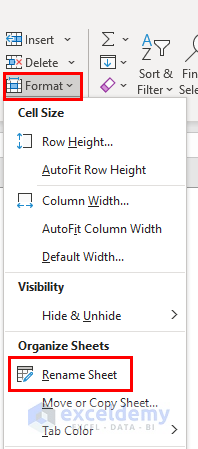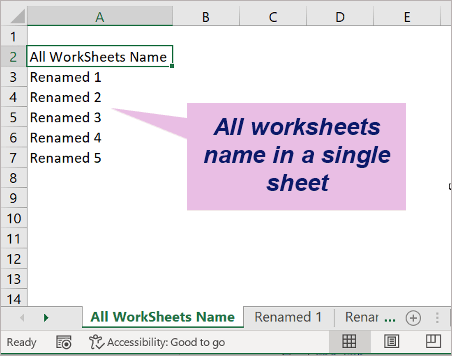3 Ways to Rename Excel Tabs Automatically with VBA

Renaming Excel worksheet tabs can become quite tedious, especially when dealing with numerous files or tabs. While renaming each tab manually is practical for small spreadsheets, automating the process through Visual Basic for Applications (VBA) significantly increases efficiency. Here are three effective VBA methods to rename your Excel tabs automatically:
Method 1: Renaming Tabs Based on Cell Values

One of the most common needs in Excel is to rename tabs according to data within the sheets. Here's how you can achieve this:
- Open your Excel workbook: Ensure you have macros enabled (go to File > Options > Trust Center > Trust Center Settings > Macro Settings, and select "Enable all macros").
- Press Alt + F11 to open the VBA editor. Navigate to Insert > Module to add a new module.
- Paste this VBA code into the module:
Sub RenameTabsFromCell()
Dim ws As Worksheet
Dim tabNameCell As Range
For Each ws In ThisWorkbook.Worksheets
Set tabNameCell = ws.Range("A1")
If Not IsEmpty(tabNameCell.Value) Then
ws.Name = Left(tabNameCell.Value, 31)
End If
Next ws
End Sub
⚠️ Note: The code uses cell A1 to name the tabs. Adjust "A1" if your data is in a different cell.
Method 2: Renaming Tabs with a Pattern

This method is useful when you want to give your tabs a consistent naming pattern, say, "Tab1", "Tab2", etc.:
- Follow the same steps to open the VBA editor.
- Paste this VBA script:
Sub RenameTabsWithPattern()
Dim ws As Worksheet
Dim counter As Integer: counter = 1
For Each ws In ThisWorkbook.Worksheets
If ws.Index <> ThisWorkbook.Worksheets.Count Then
ws.Name = "Tab" & counter
counter = counter + 1
End If
Next ws
End Sub
✏️ Note: The code excludes the last sheet, assuming it might be a summary or control sheet.
Method 3: Conditional Naming

Sometimes you need to rename tabs based on certain conditions. Here's a script that renames tabs if a specific cell contains a particular value:
- Open the VBA editor as in previous methods.
- Insert the following code:
Sub ConditionalTabRenaming()
Dim ws As Worksheet
Dim cellValue As String: cellValue = "Important"
For Each ws In ThisWorkbook.Worksheets
If ws.Range("B1").Value = cellValue Then
ws.Name = "Important_" & ws.Name
End If
Next ws
End Sub
🔄 Note: Adjust "B1" and "Important" in the code to match your specific conditions.
Integrating These Methods

To make the most of these VBA methods, consider the following:
- Develop a button for each macro in Excel to easily run them.
- Set error handling in your code to manage potential issues like duplicate names or invalid cell values.
- Test in a sample workbook before using on critical data to ensure you get the desired outcome.
By automating the tab renaming process, you not only save time but also reduce the potential for human error. Whether you need to rename based on cell content, apply a sequential pattern, or meet specific conditions, these VBA techniques provide robust solutions for managing your Excel sheets effectively. Remember to tailor these scripts to your unique requirements, ensuring they fit seamlessly into your existing workflows. While these methods are straightforward, they can be expanded or combined to cater to more complex scenarios, providing you with a versatile toolkit for Excel tab management.
Can I use these VBA methods on a shared workbook?

+
Yes, you can use these VBA methods in a shared workbook, but be cautious as changes made by VBA scripts might affect collaboration and require specific permissions or settings to execute properly.
What if the tab name exceeds Excel’s character limit?

+
Excel limits tab names to 31 characters. If your tab name exceeds this, it will be truncated. You can adjust the code to automatically shorten names if they are too long.
How can I prevent name conflicts when renaming tabs?

+
Ensure uniqueness in names by adding numbers or prefixes. The VBA script can check for duplicates and append a number or symbol to ensure each name is unique.
Are these VBA methods compatible with all versions of Excel?

+
The methods described work with most modern versions of Excel, including Excel 2010 and later. However, features or functionalities might differ slightly in older versions.



